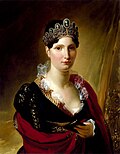Top Qs
Timeline
Chat
Perspective
List of grand dukes of Tuscany
From Wikipedia, the free encyclopedia
Remove ads
This is a list of grand dukes of Tuscany. The title was created on 27 August 1569 by a papal bull of Pope Pius V to Cosimo I de' Medici, member of the illustrious House of Medici. His coronation took place in Rome on 5 March 1570 by the hands of the Pope himself.[1]
Cosimo's family, the Medici dynasty, had been ruling the Florentine Republic, the predecessor of the Grand Duchy of Tuscany, since 1434, first as Lords of Florence and later as Dukes.[2] The title of Grand Duke, was in fact the second title of recognition within the Tuscan politics given by a Pope to the Medici family, the first being that of Duke of the Florentine Republic, created by Pope Clement VII in 1532.[3][4]
The official residence of the Grand Dukes was the Palazzo Pitti in Florence, bought by the Medici in 1549.[5]
Remove ads
Background
Margraves reigned in the 9th century when the region was part of the Margraviate of Tuscany. Beginning in the 11th century, the region was fully divided into several independent cities, which included Pisa, Florence, Siena, Lucca, Arezzo among others. However, with the territorial expansion of Florence, Tuscany began to "come together" again under one single leadership. This situation became even clearer with the creation of the Grand Duchy of Tuscany in 1569. Over the years, the Grand duchy managed to absorb practically the entire region of present-day Tuscany, until its own final annexation to the Kingdom of Italy.[6]
Remove ads
Medici grand dukes of Tuscany, 1569–1737
Summarize
Perspective
The Grand Duchy of Tuscany was the first period after centuries of political divisions, when most of the region was under the rule of a single leader. The Grand Duchy's territory comprised almost the entire region of present-day Tuscany, with the exception of the Republic of Lucca, the Principality of Piombino, the Duchy of Massa and Carrara and the State of the Presidi.[7]
Remove ads
Habsburg-Lorraine grand dukes of Tuscany, 1737–1801
Bourbon-Parma kings of Etruria, 1801–1807
Period that the Bourbon-Parma were placed as "Kings" by Napoleon in the Kingdom of Etruria. The Kingdom was a creation of Napoleon to replace the Grand Duchy of Tuscany, comprising a large part of modern Tuscany.[8]
Remove ads
Bonaparte grand dukes of Tuscany, 1809–1814
Tuscany was annexed by France in 1807. Napoleon's sister Elisa Bonaparte was given the honorary title of "Grand Duchess of Tuscany" in 1809, but did not actually rule over the region.
Remove ads
Habsburg-Lorraine grand dukes of Tuscany, 1814–1860
Leopoldo II was driven from Tuscany by revolution from 21 February to 12 April 1849, and again on 27 April 1859. He abdicated in favor of his son, Ferdinando IV, on 21 July 1859, but Ferdinando IV was never recognized in Tuscany, and was deposed by the provisional government on 16 August. Tuscany was annexed by Piedmont-Sardinia on 22 March 1860.[9]
Remove ads
See also
References
Wikiwand - on
Seamless Wikipedia browsing. On steroids.
Remove ads


















